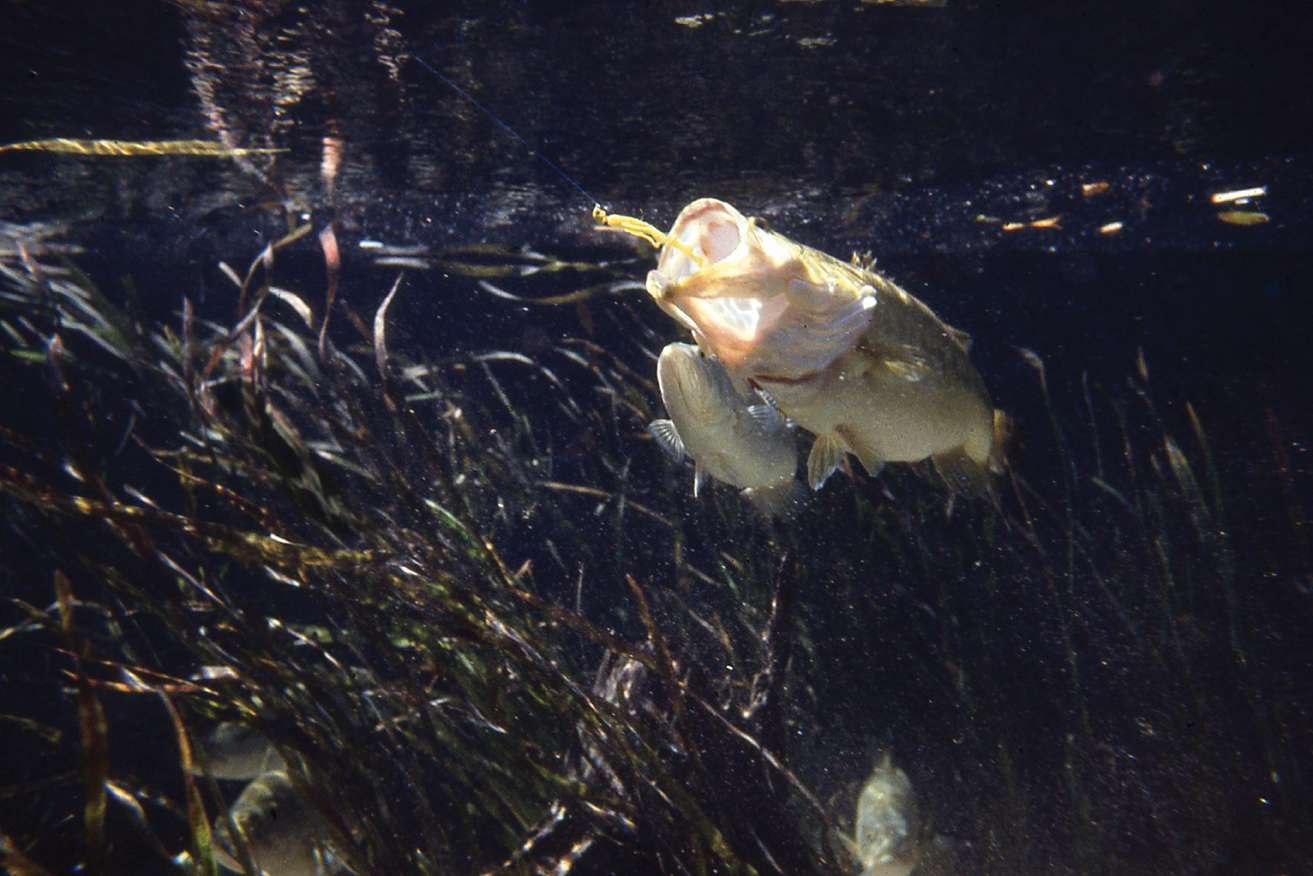
More than any other season, summer has its good and bad sides. For the good side, summer is the most predictable of all the seasons, and bass patterns are the most stable. On the bad side, bass can become lethargic and difficult to catch at times. The best thing you can do is spend lots of time on the water and tune in to what the fish are doing and, just as importantly, when they’re doing it.
After the spawn, individual bass establish themselves in one of two groups: ambush feeders or schoolers. Ambush feeders are loners and take up residence in a specific place. They’ll stay there until the food supply in the area no longer meets their needs. Then they find a new feeding area. As their name indicates, they ambush their prey and rely on short bursts of speed to catch what they eat. As a result, they’re relatively short and stocky. Schoolers join together with other bass to feed as a group. They move with baitfish schools and tend to be longer and slimmer than ambush feeders.
Current Events
In summer, moving water and bass go together. If you can find moving water, you’re well on your way to finding and catching bass. Any current is helpful, but if the current is constant and reliable, it’s even better. Bass like current in the summer for several reasons. First, it brings food to them. Current also tends to carry more oxygen than water that’s not moving. This helps to keep the fish active.
For 20 years, I had a 5-acre pond behind my house. One summer I decided to conduct an experiment with current. I put an electric pump in the pond and ran a hose out toward the middle. When I turned the pump on, it created an artificial current. I left it on overnight so the fish could get used to it, and then I went out the next morning to do a little fishing. Casting a crankbait out into the current created by the pump, I caught bass after bass. Once I turned to pump off, eliminating the current, the bite fell off dramatically.
If you can’t find (or create) current on your favorite bass water during summer, you might try fishing at night. Especially in clear water, bass are more likely to feed at night than they are during the day. This is especially true of big bass. If you’ve ever wondered what happens to all the big bass once summer comes along, you’ll be interested to know that they shut down almost completely during the day, when most anglers are on the water. They move into the heaviest cover they can find, usually near deep water, and sleep through much of the day.
Yes, I believe bass sleep. On many occasions I’ve seen them resting on or near the bottom with just one gill moving and one pectoral fin holding them in place. When I swam up to them and touched them, they darted off quickly, so I know these bass were not sick or dying. Big bass are a lot like deer in that they typically become nocturnal during hot weather.
After Dark
If you’re interested in night fishing for bass, the best advice I can offer is that you not get started until well after dark. The period from sundown until then is usually unproductive. Some have speculated that the bass’ eyes are adjusting at this time and they’re trying to gain their night vision, but I don’t think so. Based upon my observations, between sundown and 10 p.m., the bass are moving and gathering. It’s not until later that they’re ready to feed. A lot of their activity depends upon the moon. Several days before the full moon is a good time to catch nighttime bass on surface lures. Prop baits are among my favorites. Cast them out and let them sit for 30 seconds or so before twitching them very slightly. I gradually increase how hard I’ll twitch the bait until I’m moving it about 6 inches at a time. It’s a terrific method after dark when the moon is almost full. My biggest nighttime bass weighed 12 1/2 pounds and hit a topwater bait.
Another tip that will improve your night fishing is to make sure you’re familiar with the area you plan to fish before the sun goes down. The last thing you want to do is disrupt the solitude of the darkness by stumbling into your area after dark, running your boat into a stump, making a lot of noise, flashing a light across the water or otherwise alerting every bass in the area to your presence. You need to slip in slowly and quietly with your trolling motor on the lowest speed. Your first cast needs to be right on the money, and you need to be there without the bass knowing about it.
If night fishing isn’t your idea of fun, you can still catch summertime bass during the day if you’re willing to put in the time and effort to do it. In Florida, where I live, summer seems to last six months or more. At the beginning of the warmwater period, there are times when bass feed voraciously, putting on weight after the spawn. When that’s happening, anyone can catch them. More often, though, the bass are selective about when and where they eat. This is when there’s no shortcut to time on the water, observing conditions and learning about the daily habits of bass on your favorite waters.
Dinner Bells
One of the key summer feeding periods on some of my favorite waters comes between 5 and 7 p.m. Here in Florida, in the months of May and June, those hours can be magic for big bass. Again, once the sun goes down, generally after 8 p.m. in the summer, the bite will likely shut off for a couple of hours. The “magic hours” may vary somewhat for you, depending on where you live. You’ll have to get out there and unlock the secrets of your lake to find out. That takes time and dedication, but it’s more than worth the effort. I’ll cover that in more detail later.
In the early 1980s, I enjoyed my best summer of trophy bass fishing. Over a period of 40 days in May and June on a single 50-acre lake, I caught 82 largemouth that weighed 10 pounds or more. They all came between 5 and 7 p.m., and I never would have found or caught them without learning their habits by going out day after day and observing. I caught most of the bass on 10-inch golden shiners. The biggest weighed 13 1/2 pounds, but I lost one that would have weighed at least 16 pounds. I used the big shiners to keep small bass away. You might think that I was catching the same bass repeatedly, but that’s not the case. I marked each big bass I caught before releasing it, and I only caught one of the 10-pounders twice.
Glen’s Secret
Summer is a great time to create your own feeding area. It’s a trick I use to activate bass when fishing is slow. To do it, you need a boat with an outboard motor, an area with weed cover that you know holds some bass, and a little patience. Start by driving into and through the vegetation, churning it up and generally disturbing anything that lives there. By tearing up the weeds and pads, you dislodge lots of small organisms and start a feeding chain. The predators — usually starting with bluegill — move in and begin to feed on the smaller forage. The bass come in to eat the bluegill.
Once you’ve gotten everything stirred up, it’s time to get into position. Put yourself within easy casting distance, anchor, wait and watch. It usually takes about 30 minutes for things to get going. Don’t mess it up by casting into the area too early. That could alarm the bass that are looking for an easy meal. Instead, wait until you see some bluegill moving in to feed or until you see signs of bass feeding on the bluegill. This technique is great almost anytime. There’s something about a feeding opportunity they can’t ignore, even if they’ve just eaten.
My favorite baits for this method are soft plastic craws and tubes. I fish them weightless or with a 1/8-ounce sinker. I like them to settle very slowly after they hit the water on a cast. Most of your strikes will come on the initial fall.
I call this method “Glen’s Secret” because I’ve kept it to myself until now. It’s absolutely deadly and will catch bass any time of the year when you have healthy green vegetation, though it’s at its best during the dog days of summer. Try it, be patient and let the bass come to you.
Originally published July 2011.
To see the entire July/August 2011 issue of Bassmaster Magazine, click here.





